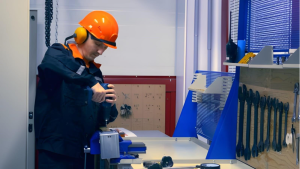
Safety is paramount in every industrial and commercial facility across Canada. Facility managers and safety officers in these environments face the ongoing challenge of maintaining a secure workplace while ensuring compliance with Canadian workplace safety standards.
Professional assembly plays a critical role in every commercial facility by expertly installing safety-critical components—such as guardrails, compliance signage, and safety barriers—according to CSA and provincial OH&S regulations, helping reduce risks and maintain compliance.
This blog explores how professional assembly services in Canada enhance industrial and commercial facility safety, improve regulatory adherence, and protect both workers and operations from costly penalties.
The Growing Importance of Facility Safety and Compliance in Canada
In Canadian industrial and commercial environments, safety isn’t just about protecting employees—it’s a legal and ethical obligation. Regulatory bodies such as the Canadian Centre for Occupational Health and Safety (CCOHS) and provincial ministries of labour enforce strict safety standards to minimize workplace hazards.
Consequences of Non-Compliance:
- Severe fines and legal liabilities under provincial OH&S Acts
- Work stoppages and operational downtime
- Increased injury rates and compensation claims
- Reputational damage and audit failure
Facility safety involves multiple protective layers—from physical barriers and signage to documentation and audits. Professional assembly services for business ensure these systems are installed correctly, perform reliably, and comply with Canadian standards such as CSA, NBCC, and CEC.
1. Expert Guardrail Installation for Physical Protection
Guardrails are among the most essential safety features in Canadian facilities. They prevent falls, protect machinery, and restrict access to hazardous zones.
Why Professional Guardrail Installation is Critical:
- Precision and Stability: Proper anchoring ensures guardrails can withstand impact loads specified by CSA standards and provincial building codes.
- Correct Placement: Experts assess high-risk areas—like elevated platforms and loading docks—to ensure compliance with Ontario OH&S clearance and fall protection regulations.
- Material Selection: Depending on your facility (e.g., food processing, manufacturing, or logistics), professionals select corrosion-resistant or impact-rated materials.
Improperly installed guardrails can collapse or loosen, creating hazards instead of preventing them. Canadian-certified installers follow NBCC and CSA specifications to ensure long-lasting, compliant safety solutions.
2. Compliance Signage Installation: Clear Communication Saves Lives
Safety signage is a fundamental part of any Canadian workplace safety program. Signs communicate hazards, safe work procedures, and emergency instructions.
How Professionals Ensure Compliant Safety Signage:
- Regulatory Adherence: Experts ensure compliance with CCOHS and CSA Z321 standards for color, text size, and symbol clarity.
- Strategic Placement: Signs are installed in high-visibility locations—near hazard zones, exits, and workstations—per NBCC guidelines.
- Durability and Visibility: Professional installation services in Canada select weather-, chemical-, and impact-resistant materials suited for Canadian climates.
Effective safety signage minimizes accidents and ensures all workers, contractors, and visitors can quickly recognize and respond to potential hazards.
3. Safety Barrier Setup: Controlling Access and Preventing Hazards
Safety barriers are essential for separating pedestrian and equipment zones, reducing collision risks, and defining restricted areas.
The Role of Professional Assembly in Barrier Installation:
- Customized Solutions: Experts evaluate facility layouts and operational flow to recommend and install CSA-compliant barriers, such as steel bollards or modular barricades.
- Secure Anchoring: Proper fastening using NBCC-approved anchoring methods prevents movement or collapse.
- Workflow Integration: Professionals ensure barriers maintain protection without obstructing material handling or personnel flow.
Professionally installed barriers help prevent accidents caused by unauthorized access or vehicle movement, supporting both worker safety and regulatory compliance.
4. Risk Reduction Through Professional Assembly
At the heart of safety and compliance lies effective risk management. Certified Canadian assembly experts minimize hazards through technical precision and adherence to national standards.
How Professional Assemblers Reduce Risk:
- Comprehensive Site Assessments: Evaluations identify hazards before installation begins.
- Consistent Quality: All installations follow CSA and manufacturer guidelines to ensure safety-critical systems perform as designed.
- Maintenance Planning: Many providers include post-installation inspections and maintenance schedules, as recommended by CCOHS and provincial OH&S authorities.
By mitigating hazards proactively, professional assembly enhances worker safety and reduces the likelihood of costly incidents or investigations.
5. Regulatory Adherence: Navigating Canadian Safety Standards
Navigating multiple Canadian safety codes and standards can be complex. Facilities must comply with national frameworks like CSA, CCOHS, and NBCC, alongside provincial OH&S Acts such as:
- Ontario OHSA
- Alberta OH&S Code
- British Columbia Workers Compensation Act
How Professional Installation Services in Canada Ensure Compliance:
- Up-to-Date Knowledge: Experts stay informed on updates to CSA, NBCC, and provincial legislation.
- Proper Documentation: Certified installers provide inspection and compliance reports for audits or safety reviews.
- Collaboration with Safety Officers: Professionals coordinate with in-house safety teams to align with internal safety programs.
This expertise ensures your facility meets or exceeds Canadian safety standards, reducing liability and protecting your workforce.
6. Why Canadian Facility Managers Trust Professional Assembly
For facility managers and safety officers in Canada, outsourcing to certified installers ensures installations meet all regulatory and performance requirements—while minimizing risk and downtime.
Benefits of Professional Assembly Services:
- Specialized Tools & Equipment: Technicians use CSA-rated tools and methods for precision.
- Experienced Teams: Trained professionals understand Canadian workplace safety standards and industry nuances.
- Time Efficiency: Streamlined processes reduce operational disruptions.
By trusting professional assembly services for business, managers gain peace of mind knowing every guardrail, barrier, and sign meets strict Canadian safety codes.
Conclusion
Facility safety and compliance in Canada require more than the right products—they demand expert installation aligned with CSA, CCOHS, and provincial OH&S standards.
From guardrail installation and safety barrier setup to compliance signage, professional assembly ensures your facility is safe, efficient, and audit-ready.
For facility managers across Ontario, Alberta, and beyond, hiring expert assembly services in Canada is the most reliable way to protect employees, reduce liabilities, and maintain long-term compliance.
Ensure your facility is safe, compliant, and audit-ready—contact us today to schedule professional installation and assembly services.
Frequently Asked Questions (FAQ)
Q1: What safety components require professional installation?
Guardrails, compliance signage, and safety barriers must be professionally installed to meet CSA, CCOHS, and provincial OH&S standards.
Q2: Can in-house teams install safety equipment effectively?
While some can handle basic tasks, certified installers have specialized tools and regulatory knowledge for complex safety systems.
Q3: How does professional assembly reduce liability risks?
Proper installation prevents equipment failure, ensuring compliance with Canadian safety codes and reducing the risk of legal claims.
Q4: What standards do professional assembly teams in Canada follow?
Installers adhere to CSA, CCOHS, NBCC, CEC, and provincial OH&S Acts, ensuring installations are nationally compliant.
Q5: How often should safety systems be inspected?
Regular inspections—quarterly or biannually—are recommended under CCOHS and provincial OH&S guidelines to maintain safety performance.



